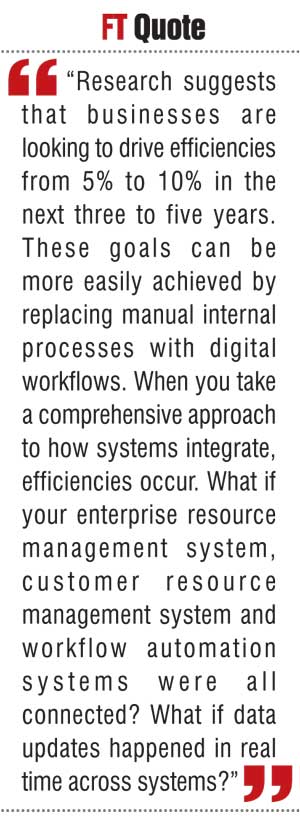Sunday Dec 15, 2024
Sunday Dec 15, 2024
Thursday, 3 November 2016 00:00 - - {{hitsCtrl.values.hits}}
By Jacqueline Gimenez - Global Marketing
Manager, ESRI
Mobile. Big data. The Internet of Things. The cloud. The 21st Century global economy began digital and it’s only picking up speed. Yet despite the technological advances, digital transformation as a strategic discipline has lagged behind, only now appearing on radars. Whether involved in banking, telecommunications, or government, executives must ask themselves the big digital questions — how are we digital? What’s our digital maturity? Who’s using paper where we should be digital?
Research suggests that businesses are looking to drive efficiencies from 5% to 10% in the next three to five years. These goals can be more easily achieved by replacing manual internal processes with digital workflows. When you take a comprehensive approach to how systems integrate, efficiencies occur. What if your enterprise resource management system, customer resource management system and workflow automation systems were all connected? What if data updates happened in real time across systems?
Yet companies are struggling to understand how a digital transformation strategy can be applied to marketing, operations, selling and the bottom line. They need to assess their digital quotient, how much of their organisation is digital, and how much needs to be automated to embrace digital transformation.
Analysts and influencers are taking notice of the modern digital world. Noted author and principal analyst Brian Solis of the Altimeter Group released a maturity model for digital transformation in a new report, The Race against Digital Darwinism: Six Stages of Digital Transformation. The McKinsey Group has developed a metric for the digital maturity of a company, called a digital quotient that evaluates 18 practices related to digital strategy, capabilities and culture.
As more organisations envision an all-digital experience and look to employ digital processes, deliver modern capabilities and foster a culture of growth and change, how they achieve their goals becomes an exhausting question.
Location-based solutions
But what if the question wasn’t how, but where? What if location-based solutions truly hit the mark or provided the treasure chest for successful digital transformation?
Geographic information system (GIS) technology, which includes enterprise systems, cloud-based solutions, apps, and mobile capabilities, is easy to use and allows businesses to work more efficiently. This greatly improves how companies can grow their digital quotient.
Why? Because the best possible digital approach begins holistically. Maps and location serve as the framework for integration. On the back end, where systems are built and managed, GIS technology links customer relationship management (CRM), business intelligence (BI), records management, asset management and many other systems. On the front end, where workers and customers consume information from mobile devices, computers and the IoT, maps serve as the perfect custom common operating picture to give people what they need.
Give your CEO and CIO a dashboard. Give your field crews and customer service reps mobile data. Provide analysts with sophisticated analysis to perform otherworldly algorithms, models and calculations. And make it all available on maps that are inherently intuitive and provide visual discernment and understanding. People process information faster when it’s visual. Maps make it easy to see patterns that are hidden within spreadsheets and tables.
GIS provides an end-to-end digital solution that is fast, agile, connected and responsive. The advanced technology unlocks a kind of location enablement that serves as the core of digital. How? It enables customer engagement, decision support, field mobility, superior analytics and data management. And it does this by unlocking the data your organisation already has.
Simply put, GIS meets the evolving needs of staff and customers to access data, anytime and anywhere, on easy-to-use apps. At the same time, GIS are enterprise-wide systems that replace repetitive and outdated processes that are time-consuming and error prone. Instead of staff collecting data on paper or in siloed systems, they can use map technology to create a centre of gravity for data collection. This makes data available throughout an organisation and to its external partners and saves massive amounts of time compared to inputting paper records or processing data requests between departments.
Location for digital transformation
Today’s forward-thinking companies rely on location for digital transformation. For example, Walgreens uses GIS-based digital processes to assess, in real time, the stock levels of flu medication within each retail location to optimise supply levels and sales. A real-time product supply offers superior service to customers and helps an organisation like Walgreens be more profitable.
In banking, GIS technology speeds and optimises risk assessment, resilience planning, facility site location and marketing. Banks can map financial transactions based on origin, destination, amount and customer to identify fraudulent activity. GIS reveals the context behind data such as where marketing outreach is most effective, where competition exists, where loans default, or the impacts of demographic changes.
Trucking companies manage their fleets with real-time data about roads and weather that allows them to make more insightful decisions about how to manage their assets.
Telco companies can map service areas, customer metrics and marketing efforts to ensure outreach is aligned to need and growth opportunities in specific locations. Visualising big data on a map helps companies answer questions such as where can we gain new customers? Where is the ideal area for expansion? Where do we need to upgrade equipment for better service?
More and more industries, businesses and Government entities recognise the value of the digital processes. They are beginning to see a need for strategic planning versus tactical execution of digital capabilities. GIS serves as the perfect starting point. It can provide enterprise-wide capabilities and easily integrate with existing systems. Moreover, it supplies the perfect intuitive interface for your staff and customers alike. If you want to approach the digital transformation age, don’t ask how, ask where.
(The writer has been setting direction for marketing efforts worldwide as Esri’s Global Marketing Manager since 2011. She evangelises adoption of the ArcGIS platform and has had a hand in efforts including marketing analytics, advertising and marketing programs. Prior to Esri, Jacqueline worked for Coca-Cola, managing the Environmental Management Systems)